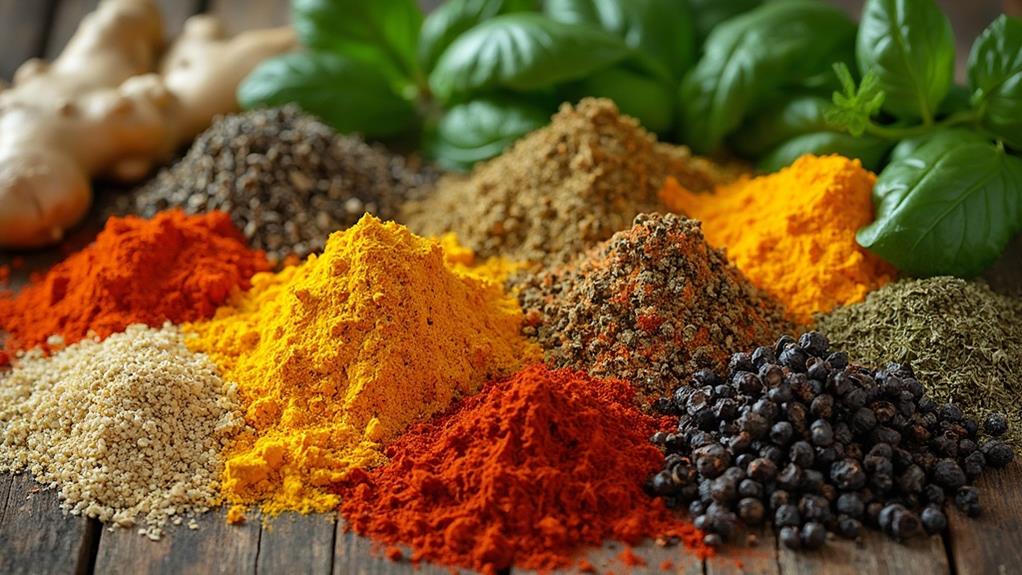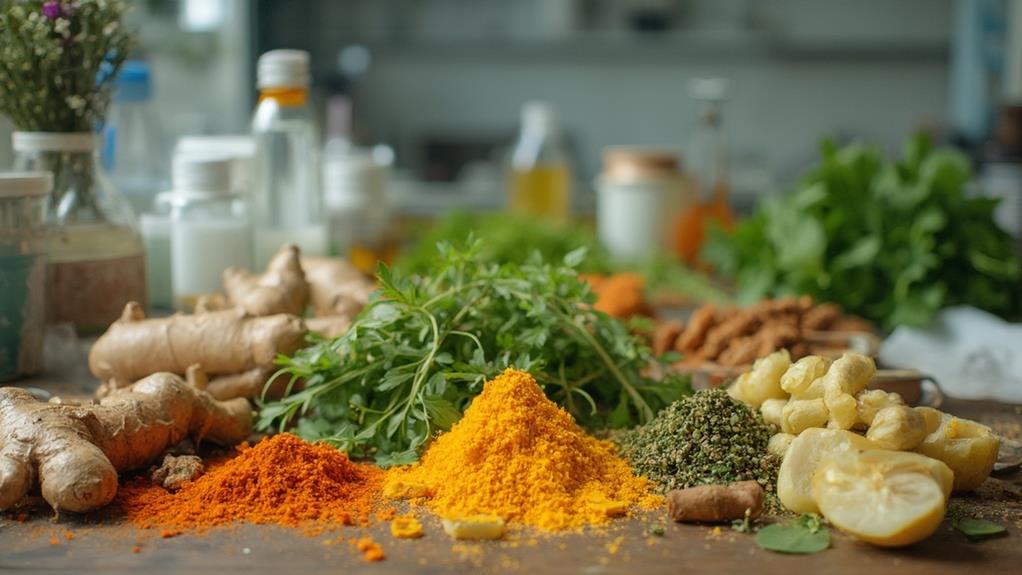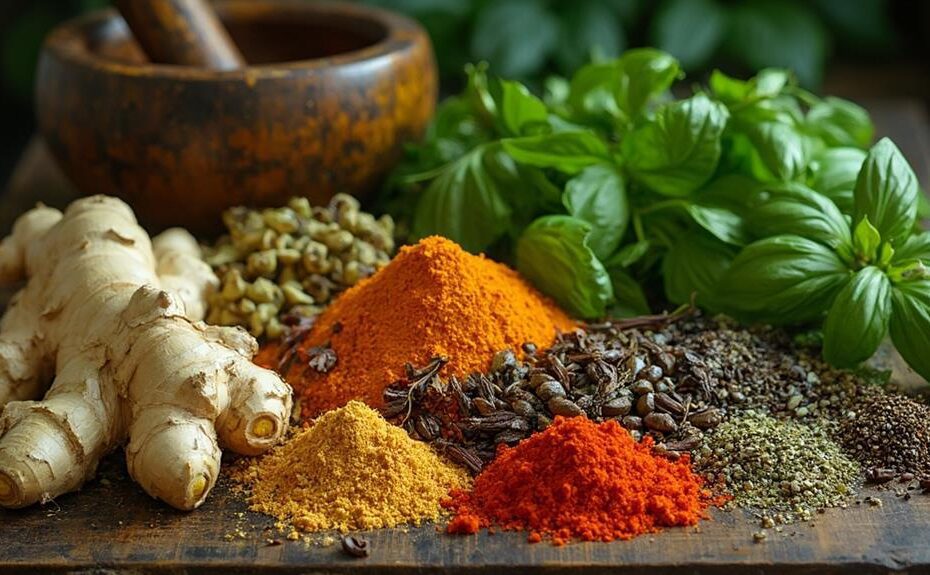Herbs and spices in Filipino cuisine serve a dual purpose, providing flavor and medicinal benefits.
Traditional remedies passed down through generations utilize common herbs like lagundi to treat coughs and pansit-pansitan to alleviate joint pain.
Garlic boosts the immune system, while turmeric supports overall health.
In many Filipino households, ginger tea is brewed to soothe digestive issues, and lemongrass is steeped for a refreshing drink.
This blend of culinary and medicinal usage reflects the culture's resilience and resourcefulness.
Historical Significance of Herbs
Herbs have played a vital role in Filipino cuisine, reflecting the country's history and cultural heritage. They not only add flavor to dishes but also tell stories of migration, trade, and local traditions. The Spanish colonization introduced new herbs, which blended with indigenous plants, creating a unique culinary identity.
Cilantro and bay leaves are commonly used herbs in Filipino cooking, adding depth to savory stews. In contrast, lemongrass and ginger bring brightness to soups. These herbs are often used in traditional Filipino dishes, such as tinola (a ginger-based chicken soup) and sinigang (a sour soup made with tamarind broth).
Regional herbs reflect local resources and culinary practices. In the Visayas, tanglad (lemongrass) is frequently used in various dishes. In Mindanao, indigenous recipes incorporate a rich variety of herbs. These plants symbolize resilience and adaptation, as Filipinos have cherished them not only for their flavors but also for their cultural significance.
Understanding the background of these herbs deepens appreciation for the culinary experiences they enrich. Each region's unique use of herbs reflects its history, cultural heritage, and local traditions. By recognizing the importance of herbs in Filipino cuisine, we can better appreciate the stories and traditions they carry with them.
Common Medicinal Herbs
Filipinos Rely on Medicinal Herbs for Health Benefits
Many Filipinos turn to common medicinal herbs for their health benefits, relying on nature's remedies passed down through generations.
Lagundi Treats Coughs and Respiratory Issues
Lagundi is one of the most popular medicinal herbs in the Philippines, known for its effectiveness in treating coughs and respiratory issues. Its leaves can be brewed into a tea for soothing relief, and it can be easily found growing in backyards.
Pansit-Pansitan Has Anti-Inflammatory Properties
Pansit-pansitan is another staple herb, renowned for its anti-inflammatory properties. Its leaves can be used to make a poultice or tea, helping to alleviate joint pain or arthritis.
Sibuyas Has Antimicrobial Properties
Sibuyas, or onion, isn't just a kitchen staple; it also has antimicrobial properties that can aid in fighting colds.
Balbas Pusa Supports Urinary Health
Balbas pusa, or cat's whiskers, is a lesser-known herb that works wonders for urinary issues and kidney health. Its leaves can be steeped in hot water or consumed as a tincture.
Bawang Supports Heart Health
Bawang, or garlic, is celebrated not just for its flavor but also for its ability to support heart health.
How Can Herbs and Spices in Filipino Cuisine Benefit Health and Wellness?
In Filipino cuisine, herbs and spices play a vital role in enhancing flavors while also offering potential health benefits. Many traditional healthy filipino cooking methods use a variety of herbs and spices like turmeric, ginger, and calamansi, which are known for their antioxidant and anti-inflammatory properties, contributing to overall wellness.
Spices With Healing Properties

Spices with Healing Properties in Filipino Cuisine
Turmeric: Anti-Inflammatory and Antioxidant Properties
Turmeric is a vibrant golden spice commonly used in Filipino cooking, known for its anti-inflammatory and antioxidant properties.
When added to dishes, turmeric not only enhances flavor but also promotes overall health.
Ginger: Soothing Digestive Issues and Reducing Nausea
Ginger is a staple spice in Filipino cooking, renowned for its ability to soothe digestive issues and reduce nausea.
Consuming ginger tea or adding fresh ginger to stir-fries taps into its natural healing powers.
Garlic: Immune-Boosting and Heart Health Benefits
Garlic is a frequently used spice in Filipino recipes, celebrated for its immune-boosting properties and heart health benefits.
Its pungent aroma adds depth to meals while helping to ward off illnesses.
Black Pepper: Aiding Digestion and Enhancing Nutrient Absorption
Black pepper is a spice that aids digestion and enhances nutrient absorption.
Incorporating these spices into daily meals supports overall well-being while enjoying the rich flavors of Filipino cuisine.
Traditional Remedies in Filipino Culture
Traditional Remedies in Filipino Culture
In Filipino culture, healing traditions thrive due to the reliance on natural remedies passed down through generations. These remedies often utilize common herbs and spices found in kitchens across the archipelago to address various ailments.
Families Rely on Traditional Remedies
Many families in the Philippines rely on these time-honored practices as both preventative and curative measures. These remedies are deeply rooted in the belief that local flora possesses healing properties.
Examples of Traditional Remedies
Several herbs and spices are commonly used in traditional remedies:
| Herb/Spice | Common Use | Preparation Method |
|---|---|---|
| Ginger | Relief from colds | Brewed as tea or added to dishes |
| Turmeric | Anti-inflammatory | Used in cooking or as a paste |
| Lemongrass | Digestive aid | Steeped in hot water for tea |
Embracing Traditional Remedies
Modern Applications and Research

Modern Applications and Research
Traditional remedies continue to hold significant cultural value in the Philippines, and modern research is now validating their effectiveness.
Universities and research institutions in the Philippines are investigating the medicinal properties of local herbs and spices, exploring their historical uses. This includes the preservation of cultural heritage, such as traditional tattooing practices.
The cultural significance of tattoos as markers of tribal identity and community belonging is being applied to the study of herbs and spices. For example, lagundi (Vitex negundo) has been found effective in treating respiratory ailments, while sambong (Blumea balsamifera) has shown potential in managing kidney stones.
Researchers are also exploring the antimicrobial properties of garlic (Allium sativum) and ginger (Zingiber officinale), which have been staples in Filipino kitchens for generations.
The integration of these herbs into modern pharmaceuticals is gaining traction, with companies developing herbal supplements based on traditional recipes.
Additionally, local farmers are cultivating these plants sustainably, ensuring their availability for future generations.
